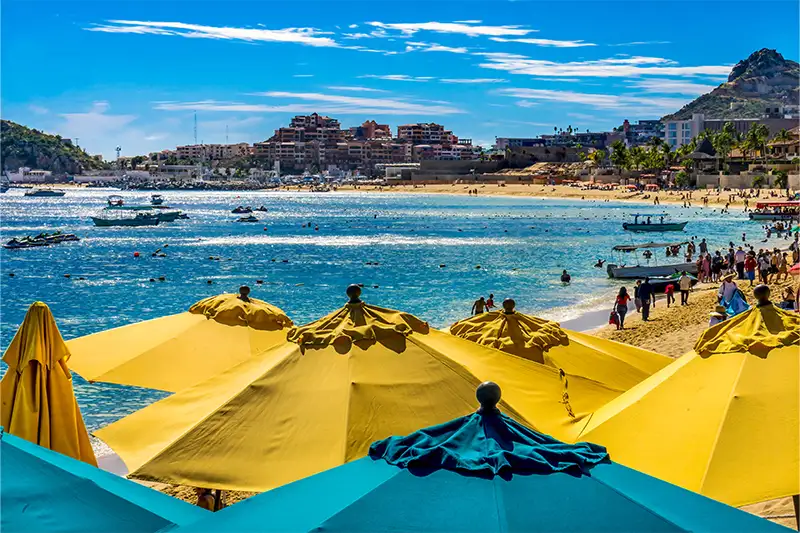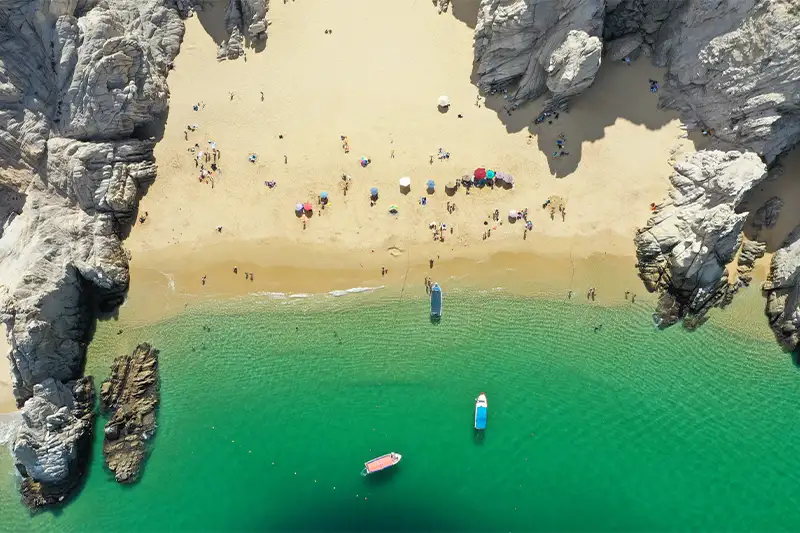Cabo San Lucas is one of the world’s prime vacation spots for good reason. Accommodations range from ultra-luxury retreats to down-to-earth glamping getaways, with levels of hospitality to match. There’s a rich, uplifting culture to enjoy; adventures galore, whether organized or not; that unbeatable Cabo San Lucas weather; and, of course, the main attraction: the vast, inviting sea, alongside the region’s other iconic natural wonders.
Still, if you’re planning a trip here, you might wonder: Is Cabo San Lucas safe? That’s a valid thing to ask, especially considering that in recent years, the city has experienced the highest crime rate in Baja California Sur.
The U.S. government recommends “increased caution” when traveling to the state of Baja California Sur, where Cabo San Lucas is located. It should be noted, however, that most forms of violence in Baja California—homicides, kidnappings, extortions, and so on—are related to the drug war, so travelers have mostly been spared.
While that’s reassuring to know, it’ll behoove you, before landing in Cabo, Mexico, to be informed about what not to do in Cabo, whether you can drink the water in Cabo San Lucas, what you need to know about swimming in Cabo, plus key information about wildlife like snakes and scorpions in Cabo San Lucas.

Tips for Safety in Cabo San Lucas
- When making your way around Cabo San Lucas, limit your explorations to daytime hours, beware of pickpockets and other thieves, don’t hail taxis off the street, and—as with any destination—if you get into an Uber, share your ride’s progress with a friend or loved one.
- Drinking water in Cabo San Lucas should be restricted only to bottled water and glasses of water poured at reputable hotels, resorts, and restaurants where your server has reassured you that what they’re serving is agua purificada—purified water. And skip the ice.
- In Cabo San Lucas, swimming in the ocean can be a risky proposition. The riptides are fierce, the jellyfish are plenty, and the lifeguards are all but nonexistent. Stick to swimming only at your hotel’s swimming pool, or at a beach that’s known to be safe, most of which are on the eastern side of the Baja Peninsula. Never enter a closed beach, and heed all posted signs and flags.
- Some of Cabo’s wildlife species are forces to be reckoned with. Snakes and scorpions in Cabo San Lucas can cause serious injuries and medical emergencies—especially rattlesnakes, yellow-bellied sea snakes, and the bark scorpion. Know how to identify and avoid these species, but if you get bitten, seek immediate medical attention. Worried about bug bites in Cabo San Lucas? The key ones to avoid include the Baja brown recluse and mosquitoes, so wear DEET and pack antihistamines
- Topping the list of what should you not do in Cabo San Lucas: drugs. Not only do they incapacitate you, making you more likely to be targeted as a victim, but if you’re caught using drugs in Cabo San Lucas, the punishment will be severe—Americans charged with drug possession can be kept in a Mexican prison for months before their cases finally go to court..
How to Get Around Safely in Cabo San Lucas
Yes, there are larger security issues going on throughout Baja California, as well as in adjacent parts of Mexico. But in Cabo San Lucas, crimes that affect tourists are mostly relegated to pickpocketing and other petty forms of theft—so hide your valuables, lock your doors, and use common sense when it comes to exploring anywhere off the beaten path or going out after dark. If you get mugged or forced to access an ATM, don’t resist—your physical safety is always more important than your money.
In terms of what to avoid in Cabo San Lucas, the U.S. Department of State recommends that travelers not hail taxis directly off the street anywhere in Mexico. Instead, use hotel transportation services or taxis that have been officially dispatched; unlicensed cab drivers have been known to scam travelers. Taxis are not metered in Cabo San Lucas, so always negotiate the price before getting in, and don’t pay until you arrive at your destination. Taking public transportation in Cabo San Lucas is not recommended either, since buses have been hijacked and theft is commonplace.
Uber runs in Cabo as well, though tensions between taxi and Uber drivers have sparked protests at times. If you decide to use a ridesharing app in Cabo San Lucas, take all the usual precautions: Share the progress of your ride with a friend or family member so that someone always knows where you are. When waiting for your ride, choose a busy, well-lit area. And when your driver arrives, confirm that his or her face and license plate match what comes up on your phone. Then sit in the back seat—never the front.
The American government also recommends that travelers in Mexico “avoid driving alone or at night” and to use toll roads when possible. If you must drive, keep your gas tank as full as possible, carry a spare tire, and charge your phone.
Natural Disasters in Cabo San Lucas
How dangerous is Cabo San Lucas in terms of natural disasters? The region is prone to hurricanes from roughly July through September; if one should hit while you’re there, take cover and follow authorities’ instructions. Baja California Sur is also subject to earthquakes and volcano eruptions, so read up on what to do in case either of those happens while you’re visiting, follow official advice, and pay attention to any and all warnings.
Drinking Water in Cabo San Lucas
Can you drink the tap water in Cabo San Lucas? The short answer: It’s not recommended. The pipes here can contaminate the Cabo San Lucas water, which often causes digestive issues for anyone not used to drinking water in Cabo right out of the faucet.
Instead, stick to bottled water, or ask your restaurant server for purified water—agua purificada—with no ice. (Speaking of drinking in Los Cabos—or anywhere you may travel—never leave your beverage or meal unattended, since spikings are not unheard of.)
Other hygienic factors to keep in mind while traveling in Los Cabos: be judicious with the street food you buy and avoid raw vegetables—similarly to the tap water, these items may be prepared in a way that your digestive system is unused to.

Swimming in Cabo San Lucas
The expansive sea, of course, is the main draw in this part (and many other parts) of Mexico. But is swimming in Cabo San Lucas safe? Not always. There’s much to know before submerging yourself in the Cabo ocean. The fiercest danger is riptides, which make many Cabo beaches unswimmable. Along with rogue waves, they regularly drown strong swimmers, tragically sweeping them out to sea. They can even knock over adults who are standing in water that’s only ankle-deep.
If you do find yourself getting pulled out by a riptide, try to stay calm and swim parallel to the beach into the breaking waves. Should you need saving, try to float, raise one arm up in the air, wave, and call for help.
Most beaches in Cabo San Lucas don’t have lifeguards, unfortunately, but officials often put out colored flags to let beach-goers know where and when swimming in the Cabo San Lucas ocean is safe—and where and when it’s not. It’s critical to obey all posted signs, never enter a closed beach, and know that this isn’t the place to rent or play around in water vehicles, since many aren’t maintained to standard. Instead, swim at your resort’s swimming pool or at a beach that’s well-known to be safe, including several on the eastern side of the Baja Peninsula.
One other danger to be alert for if you’re planning on swimming in Cabo San Lucas: jellyfish. You can wear a Lycra skin for protection, or just consider this just one more reason why you shouldn’t swim in Cabo seas.
Snakes, Scorpions, and Insects: Wildlife Dangers in Cabo San Lucas
Besides jellyfish, there are other animals to be wary of in Baja California. There are 35 species of snakes in Cabo San Lucas, about half of which are venomous. Most people never encounter one, but it’s still good to know what the poisonous snakes in Cabo San Lucas look like: The yellow-bellied sea snake looks like a floating stick in the water, while the area’s 18 species of rattlesnake are identifiable by their signature noisemakers.
Cabo’s snakes tend to hide in rock piles, brush, or trash piles, so avoid those. It helps to wear closed-toe shoes, stay on the beaten path, and carry a travel first-aid kit. If you get bitten, keep the wound below your heart and don’t cut open the wound or try to suck the venom out. Most importantly, get to a doctor or hospital as soon as possible.
Bugs in Cabo San Lucas are also worth knowing about. The Baja brown recluse spider, in particular, can cause extremely damaging bites. Identify it by its tan to brown color; long, fuzzy legs; and the “violin” pattern on its back.
Cabo has plenty of mosquitoes, too, so wear DEET repellent and pack antihistamines. There haven’t been many cases of Zika in Mexico recently, but the CDC reminds travelers that a risk of the mosquito-borne illness may still remain.
Mexico has upwards of 200 scorpion species, though only eight of those are dangerous to humans. The scorpions in Baja, Mexico, that travelers need to know about include the venomous bark scorpion, which is yellow and about three inches long. You definitely don’t want it to sting you, especially if you’re older or a child. If you do get stung, apply ice and seek medical help immediately.
Scorpions are more active in summer and at night. To keep your life free of them, tap and shake out your shoes before putting them on, shut your bags tightly so they can’t crawl in, and leave them alone if you see them. You can also carry a scorpion toxin antidote, available at some Mexican pharmacies.
—original reporting by Avital Andrews
You Might Also Like:
• The 11 Best Tour Group Travel Tour Companies for 2025• The 7 Most Affordable Transatlantic Carriers
• The 10 Least Fun Cities in America
• Should You Book a Trip on Travel Tuesday?
• 7 Air Travel Secrets You Didn’t Know
We hand-pick everything we recommend and select items through testing and reviews. Some products are sent to us free of charge with no incentive to offer a favorable review. We offer our unbiased opinions and do not accept compensation to review products. All items are in stock and prices are accurate at the time of publication. If you buy something through our links, we may earn a commission.
Related
Top Fares From
Today's Top Travel Deals
Brought to you by ShermansTravel
11-Nt Ireland Tour, Incl. Dublin, Belfast,...
smarTours
 vacation
$3870+
vacation
$3870+
New Year Sale: Luxe, 9-Nt Alaska...
Oceania Cruises
 cruise
$3599+
cruise
$3599+
Ohio: Daily Car Rentals from Cincinnati
85OFF.com
 Car Rental
$19+
Car Rental
$19+




